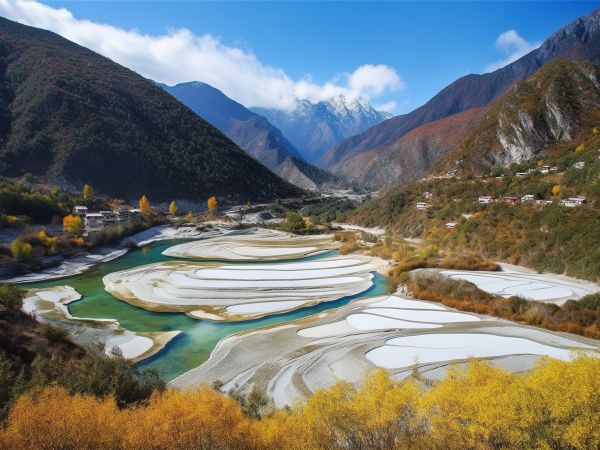Things to Do in Shangri-La
Shangri-La, formerly known as Zhongdian, is located in the northwest of Yunnan province. It is the political, economic, cultural, technological, financial and information center of the autonomous prefecture of Dêqên. In 2002, the city was renamed Shangri-La in honor of novelist James Hilton and his novel Lost Horizons. The name change meant a significant increase in the number of tourists who visited the city. It has become one of the starting points for trips to Tibet. Enjoying the reputation of a "lost paradise", Shangri-La is a place rich in natural resources and pristine historical relics. What can tourists do at Shangri-La? Here we select some interesting things to do in Shangri-La for tourists to enjoy the best of Shangri-La.

Get Closer to Nature in Potatso National Park
Potatso National Park is a nature reserve administered by the Diqing Shangri-la Province of Yunnan. The park has an area of 1,300 square kilometers. The park is famous for its primitive landscape and features several picturesque hills, meadows and lakes. It is also home to over 100 endangered species, including leopards, cranes, macaques, lynx and many more. Shudu Lake, on the north side of the park, is a 20-minute bus ride from the park entrance. At an elevation of 3,705 meters, this lake is an alpine gem. Its crystal clear waters are enjoyed by wild ducks, cranes and various species of fish, and are surrounded by tree-covered hills. Lake Bitahai, commonly considered the highlight of the park.

See Wild Fauna And Flora at Napahai Lake
Napahai Nature Reserve is an ecosystem protection zone from wetlands to seasonal plateau lakes and swamp grasslands. Every October, flocks of black-necked cranes, greylag geese, whooping cranes and woodcocks will come here, search for food and have fun. Due to the humid climate, local grass grows faster than in other areas. In May, Napahai's prairie is green, while prairie in other areas is just beginning to sprout. In early June, a variety of wildflowers open and flocks and herds frolic on the meadow. Napahai Lake is a true paradise for all types of birds, especially aquatic birds, such as the black-necked crane, the black-faced goose, as well as many other species of geese, the common mallard, the Himalayan griffon, the egret and the white-tailed eagle.

Expereince Herdsman-Life in Yila Grassland
With a total area of 13 square kilometers, Yila Grassland is the largest and most beautiful grassland in Shangri-La. It is 6 kilometers northwest of Shangri-la City, a part of Napahai Lake. It is named after the sacred mountain located to the north of the meadow. Yila Grassland is the best place to experience the life of Tibetan herdsmen in Yunnan. In summer and autumn, numerous little flowers bloom while herds of cows and sheep graze on the grass. In the dry season, the lake gradually recedes, Napahai lake became endless green grass or wetlands, grazing are the golden season. September of each year, a world of Napa Lake waterfowl, Bar-headed geese, ducks, black-necked cranes and other rare birds flown here for winter.

Learn Local History and Culture in Dukezong Ancient Town
Dukezong Ancient Town is a Tibetan town in Shangri-la District, Diqing Tibetan Autonomous Prefecture, Yunnan Province, which was built in the 7th century as a stopping point on the Tea Horse Route and a station for the Han-Tibetan trade. The 1.6 square kilometer ancient city was designed in the shape of an eight-petaled lotus flower in accordance with Tibetan Buddhist geomantic theory, and its 1,084 houses radiate outward from its center on Turtle Hill. . The city is made up of traditional Tibetan houses, ancient temples and pagodas, with narrow alleys winding between them and buildings decorated with Tibetan prayer flags of many colors. Either way, Dukezong offers visitors an authentic view of Tibetan culture and is a welcome respite from busy big city life.

Climb the Haba Snow Mountain
Haba Snow Mountain is located 120 kilometers southeast of Shangri-La city in Yunnan province. The mountain rises 5,396 m above sea level and is one of the highest peaks in Yunnan Province. It faces the highest Jade Dragon Snow Mountain and rises 3,500 meters above the upper reaches of the Yangtze River. The top of the mountain is a popular destination among amateur mountaineers and its lower slopes are traversed by the popular Tiger Leaping Gorge trail. Its massif is considered the southern end of the extensive Shaluli Mountains, which in turn are part of the Hengduan Mountains.

Taste Tibetan Meals
The food at Shangri-la has a distinctive style of plateau food that you might find in the highland area. If you don't want to go that far to Tibet, just try special plateau food in Shangri-la, what you can try are mainly Highland Barley, Butter Tea, Yak Meat, Yogurt and Tsampa. And what makes the food at Shangri-la so out of the ordinary is the Tricholoma Matsutake, which is a rare species of wild plants with abundant nutrition.

Explore Sumtsenling Monastery
Ganden Sumtsenling Monastery, also writen as Songzanlin Monastery, is a Tibetan Buddhist monastery located 5 kilometers from the city of Shangri-La. Built in 1679, it is the largest Tibetan Buddhist monastery in Yunnan and is sometimes known as the Little Potala Palace. Built in the style of the Potala Palace in Lhasa, the magnificent monastery resides on a hilltop and is composed of the two lamaseries Zhacang and Jikang - which take the form of a five-story Tibetan watchtower - five gates, numerous sub -lamaseries and hundreds of monks' rooms. The main scripture hall in the center of the complex is the highlight of the visit, especially during the morning prayer time or during auspicious festivals when devotees come to participate in the festivities.

Admire Natural Wonder of The Baishui Terrace
Baishui Terrace, or White Water Terrace, is an ancient Chinese relief between 200,000 and 300,000 years old. Covering an area of three square kilometers, Baishui Terrace is located in the foothills of Haba Snow Mountain, 101 kilometers southeast of Shangri-La County. The main attraction of the area is a huge white deposit in the shape of a stepped pool, formed by calcium-rich water gushing from springs at the top of the formation. It has been described as the largest of its kind in China.


















